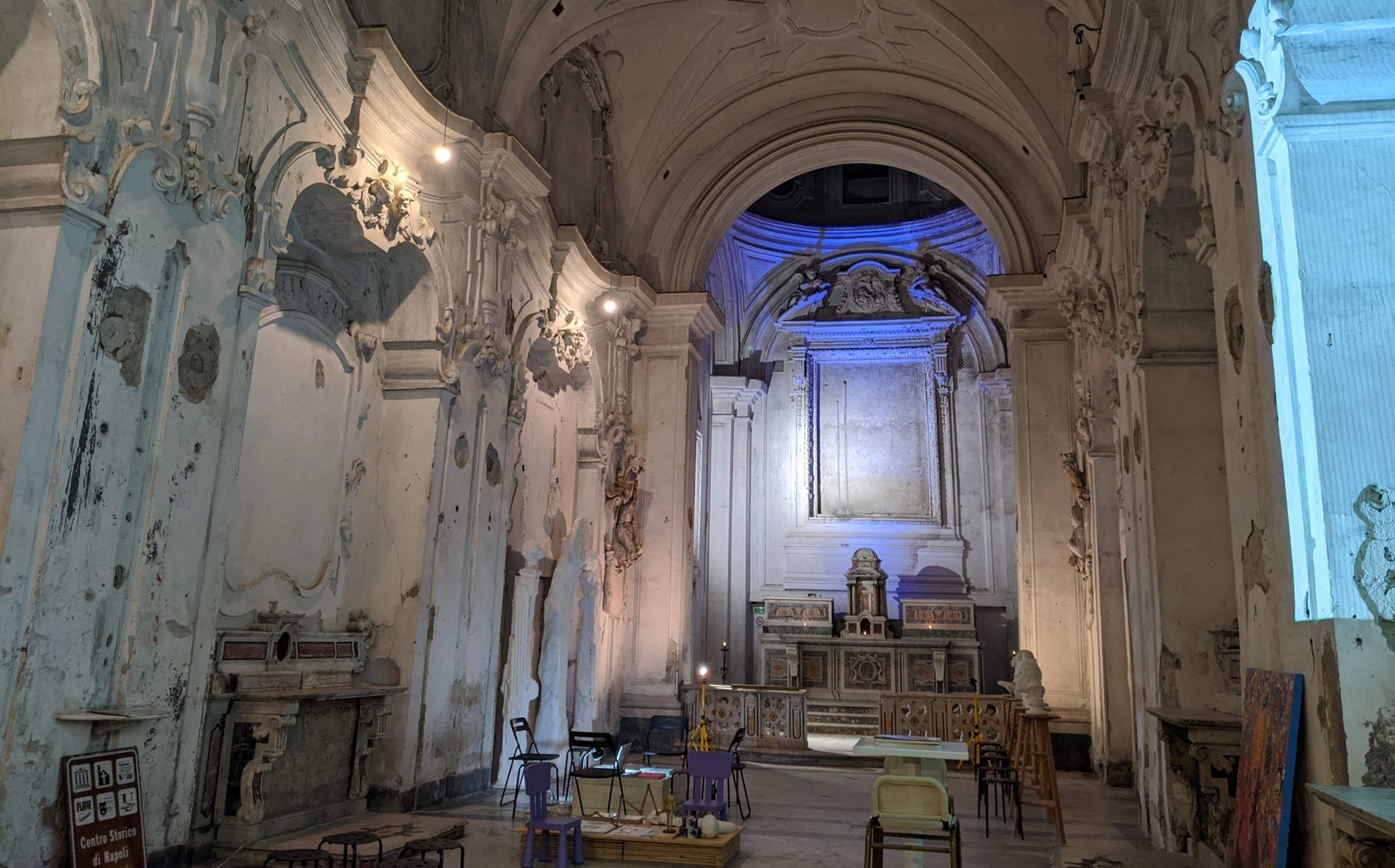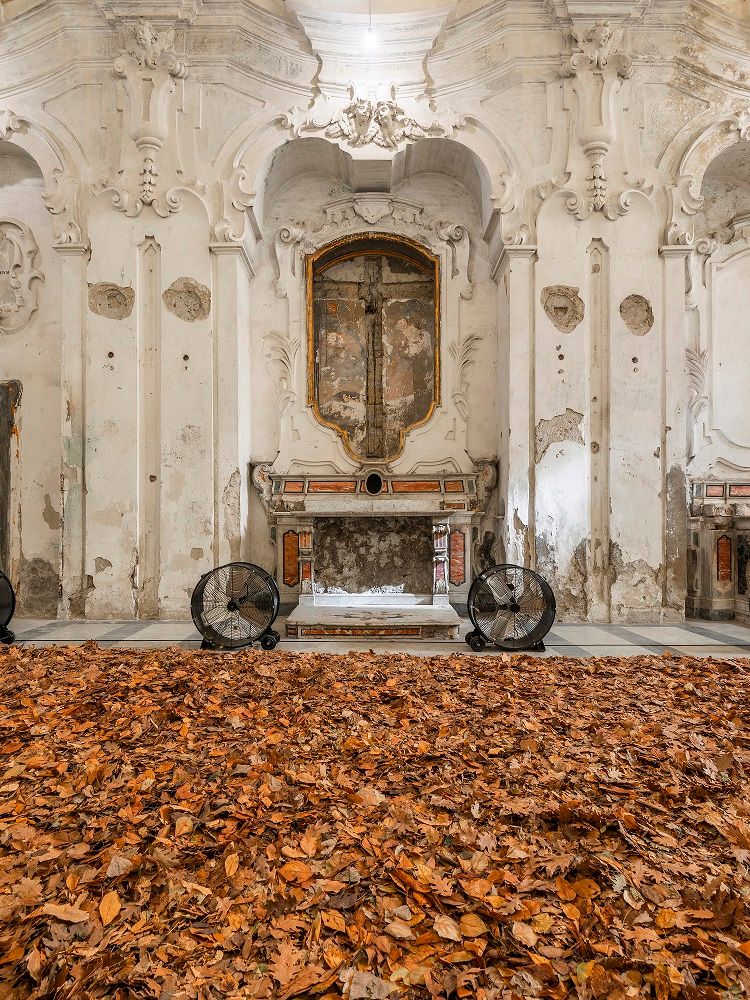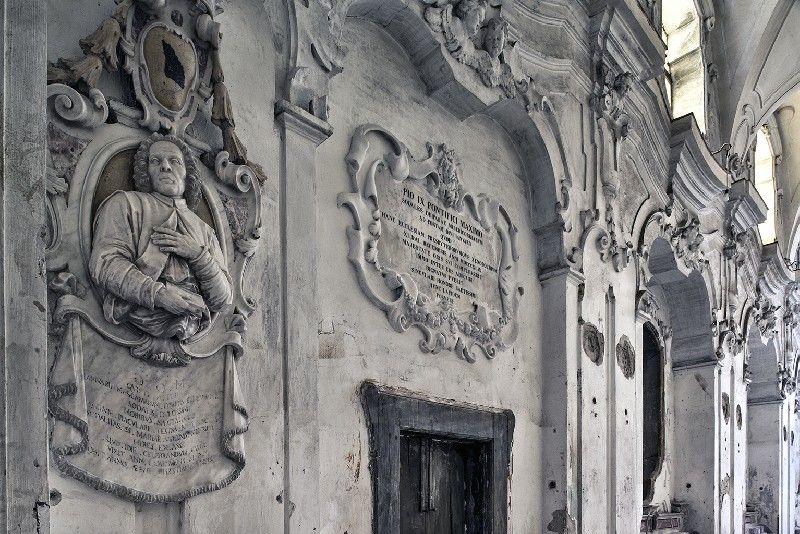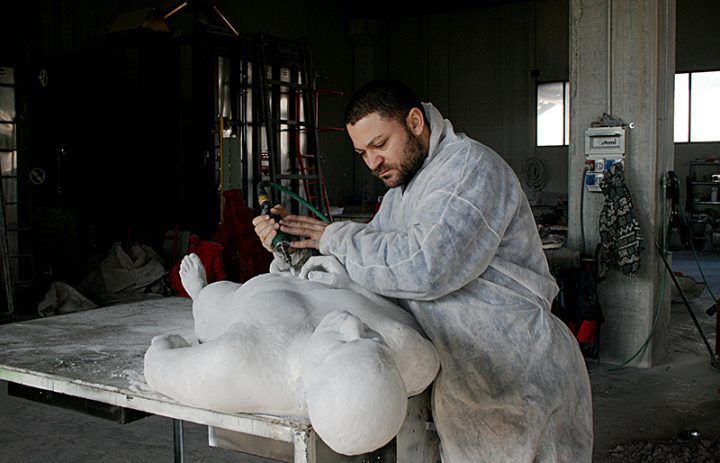THE STORY OF A CITY
By Christian Leperino

I was born in Naples, one of the most radiant and vital cities in southern Italy.
I have been working in the Sanità district for many years. Thanks to the ‘SMMAVE (Santa Maria della Misericordia ai Vergini) Centro per l’Arte Contemporanea’ organisation, which I have the honour of representing as chair, I was able to bring the ancient church of Santa Maria Della Misericordia (16th-18th century) back to life. Previously abandoned and closed for about a century, it has been transformed into a centre for contemporary art where creativity meets sacred space.
I am very grateful to all the members of the organisation, the professionals in the field of contemporary art and the volunteers who, since 2015, have been helping me take care of the Misericordiella, which had long been derelict. Thanks to an intense cleaning, restoration, research and enhancement project, we have restored and reopened this ancient monument, giving a centre for research, teaching and artistic production back to the city.
A multi-disciplinary cultural committee for the regeneration of the area, it has developed collaborations and memorandums of understanding with other organisations in the area, cultural organisations, museums and research institutions, including the Accademia di Belle Arti di Napoli (Naples Academy of Fine Arts), the Madre Museum, the National Archaeological Museum (ExtraMann network), Pio Monte della Misericordia, University ‘Federico II’, the Campania dei Festival Foundation, the Naples city council’s Ludoteca and Progetto Museo (the AAA Accogliere ad Arte network, with the patronage of the City of Naples).
The church of Santa Maria della Misericordia is part of an ancient complex, the former hospital of the Archconfraternity of the same name, and its long history has seen it abandoned and buried by the so-called “lava of the Virgins” flooding, and then rebuilt even more beautifully. Work done in the 18th-century shaped the interior more than any other intervention and the elegance of the architectural design and refined quality of the stucco reliefs survived the 20th-century wounds of abandonment and theft.
The Misericordiella stands almost at the end of the ancient path of the streams that ran from the Capodimonte hill to the area of the ‘virgins’, chosen since Greek times as a place of hermitage and burial of the dead, just outside the city walls that separated it from the city of the ‘living’. It is an area full of spirituality and memories, a place of major contrasts but rich in stimuli for those engaged in artistic research and cultural activity.
With love and passion we were committed to cleaning up, restoring and replacing the material and immaterial memories of this historic site long condemned to a fate of decay, so that it could become a centre for research, teaching, and artistic production: a space for gatherings and participation by artists, scholars and organisations.
It was a long and arduous task, carried out exclusively by volunteers, but one that has rewarded us also with the restoration of the ancient hypogeum, eight metres down, a sort of ‘Holy Land’ where the dead were buried. This space bears witness to the foundations of the oldest church, which was buried by a flood at the end of the 1500s. A place rich with history and spirituality, covered for decades by rubbish and building rubble. The church was opened to the public with site-specific installations, theatre and musical performances, art and theatre workshops, historic-artistic visits and itineraries designed to highlight the neighbourhood.


Embarking on a relationship with the area’s residents, in particular the younger ones, seemed essential to the project from the outset. We built relationships and important collaborations with the organisation that had been working there for some time as well as with educational institutions, making us pioneers in the construction of a ‘bridge’ between contemporary art and the region. The involvement of young people and children took place ‘in the field’. First they were taken on a visit of the complex to get to know a piece of heritage unknown by the neighbourhood and then led through different types of workshops to develop their skills of observation, independent re-elaboration and creativity. It is in this place, laden with history and memory, that I create my sculptures.
The juxtaposition and co-existence of ‘light and shadow’ is a typical feature of Naples, a city made of layers in which one has the sensation of walking among two metropolises. That of the living, where we are, and that of a more secret and mysterious subterranean world populated by the souls of the dead, which can be accessed through old doors or tunnels that lead to dark cisterns, necropoli and churches submerged by floods.
I try to infuse the surfaces of my works with the history of a city that has stratified over millennia, from the ancient Greek foundations, via the Roman era, to the many royal dynasties. All these epochs and styles merge into one great urban body, giving shape to a city that’s unique in the world! I grew up in a poor neighbourhood, a place that educated me that art is an aesthetic dimension of life. In an area rife with difficulties, culture for me was, and still is, the only salvation against the impoverishment of the soul. As an antithesis to the virtual immateriality of our contemporary society, I reclaim my relationship with the materials of ancient sculpture, such as clay, plaster and bronze. These require commitment and a strong physicality, which I need as an artist.
I often observe the city’s palazzi. Figures and decorative elements emerge from the architecture, such as pilasters, capitals, sculptures of seductive sirens that time and neglect have corroded and transformed into marvellous monsters, installed on grey marble portals. And then there is life, in the heart of the bassi, the alleyways and the wide vistas, which offer to the gaze an existence rich in humanity and drama. I love all these contrasts, the stories of life, the network of endless streets, where the many chiaroscuros of existence intertwine.
I like to cross the threshold of these places and inside the palazzi I let myself be seduced by the harmonious and majestic curves of the Baroque, where statues of saints or madonnas are displayed in the courtyards or on the balconies above as silent guardians countering the impending force of the volcano. Children play noisily with balls on the flagstones of building hallways, marking the perimeter of an improbable football field with stones and tin cans. I let myself be seduced and amazed by these places, especially by the yellow tufa bricks extracted from the millenary rocky hills that have become dark quarries. On the surfaces of these walls, on the faded plaster, between the cracks and the engraved marks, I can read the memory of these stones. The strength, the duality that characterises my land is drawn constantly into my artistic research.
I often go to the sea, where looking out beyond the chaos of the city takes me back to a remote time, to the echo and suggestion of Greek myths. In the black volcanic sand on shore I recover knotted ropes, pieces of wood from old shipwrecked boats, shells and elements that I use in the sculptures I create, where traces of the seabed sometimes resurface, echoes of a distant past that is alive and palpitating.

Growing up in the eastern suburbs of Naples, marked by grey and desolate non-places, Christian Leperino (Naples, 1979) studied at the Academy of Fine Arts in Naples, where he began experimenting with different media: painting and sculpture, but also photography and video. This allows him to approach the tensions and difficulties that affect his generation directly.
